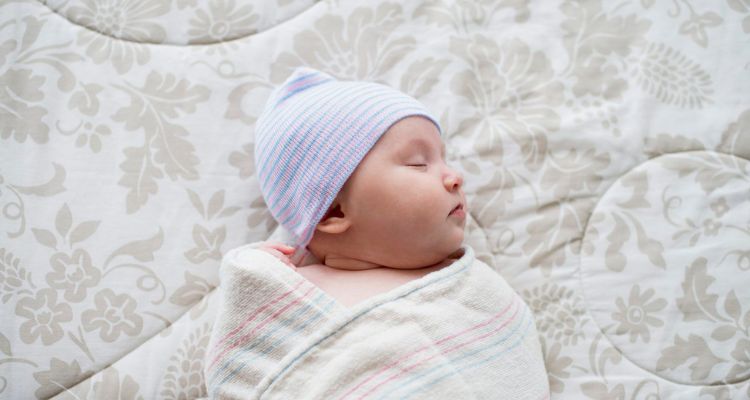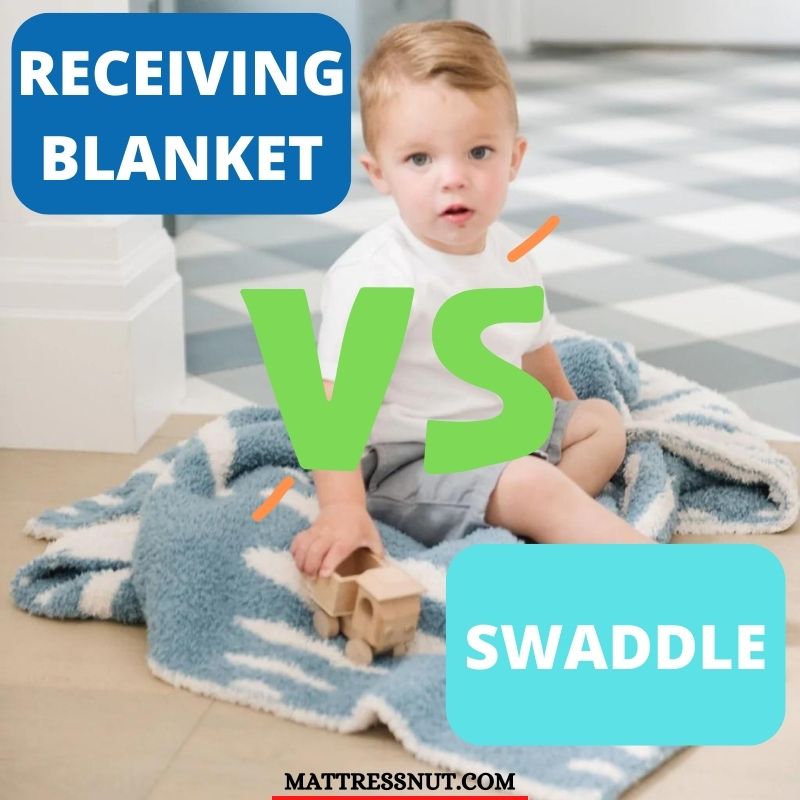Shopping for the baby stuff but can’t understand the difference between a receiving blanket and a swaddle? Well, you are not alone out there. These two items are similar and serve the same purpose in most cases.
That’s why they toss around simultaneously, and people get confused. But don’t worry! We have developed this guide for the likes of you so you can understand how these two baby accessories differ.
Let’s begin our discussion and see how they are different and which one you should consider going for, so read on.
What is a Receiving Blanket?
This blanket is lightweight and it’s thin. You can use it to swaddle, cover, or wrap your newborn. These blankets got their name “receiving” because that’s what they were conventionally referred to as in the hospital delivery room.

Hospitals would wrap the babies in these blankets and hand them over to their parents after the delivery. So, this blanket is great for the earlier months with your newborn, and you can use it later for various other things.
These receiving blankets don’t have any particular looks, and they’re made of different materials. Their standard size is either rectangular or 30-inch x 30-inch.
But there is no restriction with regard to the material type and size of these receiving blankets. You can go for a soft flannel blanket or a light cotton one.
But the classic receiving blanket, which most of you will recognize, would be that blue and red striped white-colored blanket that is used in the US hospitals.
These receiving blankets are versatile; you can swaddle and cover your baby when you’re out. These blankets are of light to prevent your little one from overheating if you want to use them for swaddling.
Keep in mind that duvets are not for babies by the NHS. Therefore, you should go for anything light to add warmth; this is where a receiving blanket comes in.
What is a Swaddle?
Now, if we look at a swaddle, it’s a blanket you can use for wrapping up or swaddling your little one. Swaddling means you can wrap your baby up from below the neck to make them feel secure and snug.
Swaddling can help your little one to sleep comfortably as it reminds them of their time in the womb. These swaddle blankets come in a range of different forms.
A conventional swaddle blanket tends to be a thin rectangular or square blanket made of cotton. It looks pretty much the same as those receiving blankets.
You can purchase premade swaddle blankets with zippers and poppers or different sizes. Therefore, these designs are much easier to fold and make your baby feel comfortable.
In other words, you don’t have to fumble in the dark anymore when trying to secure a swaddle. It’s just a quick fix now.
Receiving Blanket vs Swaddle Blanket — Which One is Better?
We are listing down some important features to compare receiving blankets with swaddle blankets and see which one of them comes out on top for each of these features,
Shape – Both are good options
You will notice immediately that receiving blankets are square and tend to be warmer and thicker than swaddles.
Swaddles are just thinner and lighter and are more on the rectangular side. It’s a tie here because both shapes can come in handy to wrap your little one.
The thinness and thickness of a blanket can also depend on what climate you live in and the current weather. So, both these blankets come in different shapes and serve different purposes.
Purpose – Receiving Blankets are a preferred choice
A receiving blanket’s purpose is to keep your baby warm as you receive them from the hospital. On the other hand, a swaddle’s purpose is to keep the baby securely wrapped, so they feel comfortable by that snugged feeling from the womb.
Receiving blankets are meant for newborns, while swaddles are meant for infants. But as receiving blankets are thicker, they tend to be more durable. It means you can use them for a variety of purposes.
You can use them in your car seats, or you can use them for cleaning. We will look at what you can use these receiving blankets for later in the article. But they are more versatile than swaddles, and that’s why the winner of this round is receiving blankets.
Materials – Swaddles are a preferred choice
Swaddles are much thinner than receiving blankets. Therefore, the materials used to construct receiving blankets are much more durable.
Swaddles tend to come with a few accessories like zippers and poppers. So, you can conveniently use them for one purpose. These are pretty colorful, and there are many designs available too.
So, regarding materials and design, various swaddles are better than receiving blankets. This is because receiving blankets are pretty simple in design as they are for one use, and that is to provide warmth to the little one.
As durable and thick, you can later use them for various purposes. But you will notice that swaddles are made of much softer and lighter materials.
We would say that in terms of variety, swaddles are better than receiving blankets. But in terms of durability, receiving blankets is quite extraordinary.

Cost – Swaddles are cost effective
There is a pretty good variety available in swaddles, so they tend to be more expensive than receiving blankets. However, they tend to be slightly larger than receiving blankets, and there are many different color options too.
Receiving blankets are available in white or lighter tones and don’t come with many bells and whistles. These receiving blankets are just rigid pieces of clothing that can provide your little one with warmth.
So, regarding quality and options, swaddles are better, but in terms of longevity and value for money, receiving blankets is much better.
Why Choose a Receiving Blanket?
Receiving blankets is useful when your little kiddo is around 1 to 2 months old. They are for keeping your little one warm after bathing.
But these blankets are tough, and you can use them for various purposes later on. However, they are great for keeping warm, so you can use them in slightly colder climates.
Here are a few things you can do with these receiving blankets once you have met the original purpose:
- Swaddling is where you can wrap your little one in eight and a breathable blanket from below the neck.
- You can use it as an extra blanket over your baby to keep it warm at night.
- Excellent for burping.
- It can be a tummy time mat.
- You can use it as a play mat.
- Conveniently use it as your breastfeeding cover.
- A makeshift bib for the little one.
- You can use it while changing your mat cover.
- It comes in handy as a car seat cover.
Why Choose a Swaddle Blanket?
A swaddle comes in handy once your little one outgrows the receiving blanket. This usually happens when s/he is between 2 to 4 months old.
- It is available in different colors and sizes. You can use it for swaddling your little one, of course.
- Later on, you can use it as a cover for the stroller or rocker.
- It is made of thin materials.
- You can use it as a cleaning or bath towel, especially for those with no poppers or zippers.
- As these swaddles are made of thinner materials, you can use them in warmer climates.
How Would I Know Whether to Go with a Receiving Blanket or a Swaddle Blanket?
You better consider this question based on mood, climate, and age. You may notice your little angel might respond well to receiving blankets earlier.
So, you can use them as soothing agents when they are only up to 1 or 2 months. Depending upon the size of your little one, you can keep these receiving blankets in use for up to 3 months. So, at this stage, you are using those receiving blankets as swaddles.
You can shift to swaddles as your little ones grow because they are much larger than receiving blankets. Swaddles are highly breathable and will prevent your baby from overheating.
From 3 months on up to 5 or 6 months, you will have to swaddle your little one as, at this stage, they tend to startle themselves. After that, they become more used to the outside world.
Receiving blankets are great for colder climates because they’re made of thicker materials. On the other hand, swaddle blankets are better for warmer climates as they are made of thinner materials.
However, you can say that receiving blankets are more multipurpose and durable as compared to swaddle blankets. On the other hand, swaddles are better in size and design availability.
Key Takeaways
What is a Receiving Blanket?
A receiving blanket is a lightweight, thin blanket traditionally used in hospitals to swaddle, cover, or wrap newborns. It’s versatile and can be used for various purposes, available in different materials and sizes.
What is a Swaddle?
A swaddle is a blanket used for wrapping up or swaddling a baby to provide a secure and snug feeling, reminiscent of the womb. Swaddle blankets come in various forms, including premade designs with zippers and poppers for convenience.
Receiving Blanket vs Swaddle Blanket — Which One is Better?
Comparing receiving blankets and swaddle blankets, both have unique features:
- Shape – Receiving blankets are square and thicker, while swaddle blankets are thinner and more rectangular, suitable for different purposes.
- Purpose – Receiving blankets are versatile and durable, suitable for various uses, while swaddle blankets are designed primarily for swaddling infants.
- Materials – Swaddle blankets are thinner and softer, with various designs, while receiving blankets are thicker and more durable, making them suitable for multiple purposes.
- Cost – Swaddle blankets tend to be more expensive due to design variety, while receiving blankets offer better longevity and value.
Why Choose a Receiving Blanket?
Receiving blankets are ideal for keeping newborns warm and can be used for multiple purposes beyond the initial swaddling phase. They are suitable for colder climates and offer versatility.
Why Choose a Swaddle Blanket?
Swaddle blankets are great for swaddling infants and are made of thinner materials, making them suitable for warmer climates. They can also be used for various purposes, such as covering strollers or as cleaning towels.
How Would I Know Whether to Go with a Receiving Blanket or a Swaddle Blanket?
Your choice between receiving blankets and swaddle blankets depends on factors like mood, climate, and age of your baby. Receiving blankets are versatile and durable, ideal for colder climates, while swaddle blankets are better for warmer weather and swaddling infants.
Conclusion
Receiving blankets and swaddle blankets might sound like similar items and might serve the same purpose, but they are two different products.
For instance, receiving blankets are smaller and made of thicker materials, and they are more durable, but they are suitable for keeping a newborn warm after bathing. They are ideal for colder climates too.
On the other hand, swaddle blankets are thinner materials suitable for warmer climates. You can use them for swaddling your baby to prevent them from startling.
Therefore, both these kinds of blankets are pretty handy at different stages. But you can say that receiving blankets tend to be more multipurpose and long-lasting, while swaddling blankets are more versatile in terms of designs and sizes available.
Resources
https://www.nhs.uk/conditions/baby/caring-for-a-newborn/what-you-will-need-for-your-baby/
https://www.chla.org/blog/rn-remedies/swaddling-do-s-and-don-ts
https://www.aap.org/en/news-room/news-releases/aap/2022/american-academy-of-pediatrics-updates-safe-sleep-recommendations-back-is-best/
Receiving blanket vs swaddle FAQs
Are swaddle blankets good or bad?
According to AAP (American Academy of Pediatrics), when swaddling is done right, it can be highly effective in calming infants down and promoting sleep.
It can assist in securing your little one while mimicking that same womb-like feel that the baby is familiar with. These blankets are lightweight and breathable materials. So, your baby won’t feel overstimulated and overheated.
Can I still swaddle with a receiving blanket?
Yes, you can use your receiving blanket to swaddle your little one. But using a swaddle blanket is much more comfortable because it is softer and stretchier and much larger than receiving blankets.
How many receiving blankets do you need for a baby?
Anywhere from 3 to 6 can be an ideal number of receiving blankets for your baby. This way, you will always have a backup blanketing your diaper bag.
You can access it when the one you are using gets dirty. The good thing about these receiving blankets is that they are durable and pretty comfortable to wash but maintain their softness after the wash.
Is a receiving blanket the same as a swaddle blanket?
No, they are for almost similar purposes. That’s why they get confused most of the time. A receiving blanket is used to keep a newborn warm after bathing. These blankets are good for about 1 to 2 months old.
Once the baby outgrows these blankets, it's time to shift to a swaddle blanket, which is for swaddling the baby to prevent them from startling themselves. These swaddle blankets are suitable for your little one at around 3 to 4 months old.

